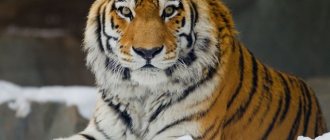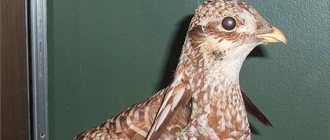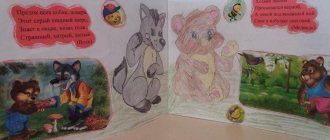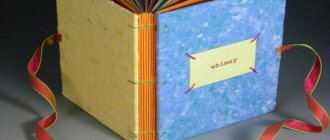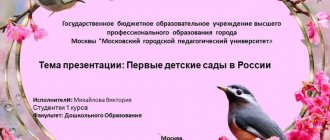Short-term research project “Red Book” (senior group)
Irina Antiukhova
Short-term research project “Red Book” (senior group)
Environmental project on the topic : “ Red Book ”
The project is short-term.
participants are children , teachers and parents.
Relevance
Can we live without nature, without birds, trees, butterflies and dragonflies, forests and meadows?
The larger our cities become, the higher the houses, the more often we want to go further out of the city to our real common home - into nature.
Man and nature... Philosophers, poets, artists of all times and peoples paid tribute to this eternal and always relevant topic. But this problem is especially acute these days, when the threat of an environmental crisis, perhaps even a catastrophe, hangs over humanity.
One of the most serious manifestations of the global environmental problem is the rapid decline in the numbers of many species of plants and animals. Some species have already disappeared irrevocably from the face of the Earth, others are on the verge of extinction. The death of animals and plants marked the path of human development.
Pollution of the atmosphere, soil, water, noise pollutants. Huge garbage dumps! Excess of fertilizers, chemical pesticides that are used to control pests! Acid rain! The main culprits for this are industry, power plants, and cars. Deforestation of large forests! Drainage of swamps, continuous expansion of roads! Forest fires! Someone wants to get more money for selling a rare animal or its fur. Someone wants to hunt for fun. Someone, without thinking, uproots flowers, kills toys with a stick, throws a stone at a bird - having fun.
Nature is majestic and rich, but at the same time fragile and vulnerable. Everyone loves nature, but, unfortunately, not everyone takes care of it. Man inflicts large and small wounds on nature. Since 1600, about 150 species of animals have become extinct on our planet. Moreover, more than half of them have been destroyed over the past 50 years!
Harm to nature does not go unnoticed. As a result of the disappearance of plants and animals, acid rain, an increase in the number of toxic landfills, etc., the Earth is increasingly losing its vitality. The main responsibility for this lies with the individual. He is also the main victim of this process. That's why thousands of organizations around the world are trying to improve the living environment.
In 1966, by decision of the International Union for Conservation of Nature and Natural Resources (IUCN)
The Red Book was first published .
Target:
Introduction to the Red Book as a state document and its
meaning.
To develop in children environmental knowledge and a caring attitude towards nature and everything around them.
Tasks:
1. Give children an idea of the diversity of nature.
2. List the main reasons for the extinction of some animals, name
protected; explain why it is necessary to protect animal and plant life
world.
3. Introduce children to how humans influence nature and for what purpose
The Red Book was created .
4. Enrich children's vocabulary.
5. Foster a love of nature and teach correct behavior in nature;
instill sympathy for living nature, teach empathy.
Dictionary enrichment:
exterminate, poachers, rarest, Red Book .
Project duration : 10 days
Project participants : children of the senior group, led by a teacher, and their parents.
Project implementation forms :
The project includes three stages : preparatory; research ;
final (summarizing)
.
Preparatory stage.
conversations " Red Book of Russia "
,
“Who are the poachers?”
, examination
illustrations of animals and plants. Equipping the subject-spatial environment (creation of the Red Book of the Saratov Region )
.
Diving into the problem: showing the presentation “The Main Book of Nature ”
Goal: acquaintance with the Red Book and its meaning .
Drawing “Animals and plants from the Red Book ”
Research stage
"We are explorers "
Which representatives of the animal and plant world are included in the Red
the books found on the territory of the Saratov region and why are they interesting?
— searching for information in children's e- books and encyclopedias (with
parents) +watching video.
What rules of behavior in nature must be followed in order to preserve
natural resources?
Didactic game “What is good and what is bad?”
The final stage
— creation of the Red Book for kindergarten
Expected Result:
- the correct attitude of children towards animals and plants is realized.
Introduction
If every person on a piece of his land did everything he could, how beautiful our land would be! (A.P. Chekhov) Take care of these lands, these waters, loving even the smallest piece of grass. Take care of all animals within nature. Kill only the beasts within yourself. (E. Yevtushenko)
Our nature has created many different creations. Animals and plants occupy a special place in it. But many are now in great danger - simply disappearing from the face of the Earth. If at the beginning of the last century only one species of animal disappeared per year, now an entire species disappears every day!
It all started with the lessons “Protection of Plants” and “Protection of Animals”. What do people do to protect animals and plants? Why did you decide to create the “Red Book”? Who's in this book? Why? What to do?
Work theme:
"The Red Book or Let's Take Protection"
Relevance : animals and plants are becoming less and less every year and their disappearance can be stopped. This topic is especially relevant in the year of ecology.
Object of study: Protection of plants and animals
Subject of research : Red Book of Karelia
Goal: Study of measures for nature conservation.
Tasks:
-Find out what the Red Book is.
— Find out what measures people take to protect plants and animals.
-Conduct a test among students “Do you know how to protect nature?”
— Meet with experts in this area
— Make a board game “In the footsteps of the Red Book”
Hypothesis:
If a person realizes how much his life depends on nature, then he will begin to treat it more carefully.
Project work on the theme “Red Book”
Table of contents
Introduction 1. Red Book. 1.1. Creation of the Red Book. 1.2. Why "red". 1.3. Colors of the Red Book. 2. Animals and plants of the Red Book. 2.1 Animals on the verge of extinction; 2.2 Endangered species of animals (rescue measures and rules of friends of nature). ConclusionList of references used
Introduction
In our modern life, you can often hear information about problems that are associated with nature.
In our environment lessons we talked about the plants and animals that surround us. They mentioned those that we can no longer see, that is, those that have disappeared. I became interested in this. This is how the idea of studying literature was born. In our modern life, you can often hear information about problems related to nature.
In our environment lessons we talked about the plants and animals that surround us. They mentioned those that we can no longer see, that is, those that have disappeared. I became interested in this. This is how the idea was born to study the literature about plants and animals of the Red Book.
Hypothesis:
The Red Book is necessary as a source of information about environmental problems. Animals and plants cannot do without human help. Will humans be able to prevent the extinction of rare, endangered species of plants and animals?
Objective of the project
: show that the creation of the Red Book is information that needs to be conveyed to people that nature needs protection.
Show which animals and plants need help and how to protect them. Get acquainted with the contents of the Red Book. Expand and deepen knowledge about the disappearance of plants and animals. Understand that caring for nature is necessary, especially now.
Relevance of the project:
In the lessons of the surrounding world, we covered the topic: “Animals”, “Rare species of animals”. So the idea was born - to create a project on this topic. Perhaps this will interest children and they will also be able to study animals and plants that need to be protected, as well as what not to do in order to preserve nature.
Red Book
Red Book
is an annotated list of rare and endangered animals, plants and fungi.
The Red Book is the main document that summarizes materials on the current state of rare and endangered species of plants and animals, on the basis of which the development of scientific and practical measures aimed at their protection, reproduction and rational use is carried out.
Creation of the Red Book
The idea of the need to create a Red Book arose in the late 50s. It originated among leading scientists from different countries united in the International Union for Conservation of Nature and Natural Resources.
At first it was presented as a book of records of endangered plant and animal species. Scientists considered it extremely important to attract the attention of the international community and the leaders of individual states to the disastrous state of nature.
The International Red Book, first published in 1996, included descriptions of 200 species of birds, about 100 species of mammals and approximately 25 thousand species of plants.
Taking this publication as a basis, many states began to create their own national Red Books.
The first Red Book in our country was published in 1978 and it was called the Red Book of the USSR. After 6 years, a second edition appeared, and then a third, more complete one. The range of animals in need of protection has been significantly expanded.
Why is the book “red”?
As you know, red is a prohibitive color:
· stop!
· stop!
· don't ruin it!
· You can’t do this anymore!
Red color
– alarm and danger signal, SOS signal! Animals and plants give us this signal. The book was called the "Red Book" to attract people's attention.
Black pages.
It contains lists of those that no longer exist in nature, those species that have completely disappeared, those that have already become extinct (for example, the sea cow, passenger pigeons and many others).
Red pages.
Here the list contains endangered and especially rare animals (for example, bison, beaver, red wolf, Amur tiger and many others)
Yellow Pages.
On these pages are those animals and plants whose numbers are decreasing every day (for example, white bears, red flamingos, pink gulls and other species).
White pages.
They show animals, of which there were not many at all times.
Gray pages.
This includes animals that have not yet been well studied, and their natural habitats are inaccessible
Green pages.
Here are the species of animals and plants that people managed to preserve and save from inevitable extinction (for example, elk, river beaver).
Red Book colors
Go to website
Return to view
The Red Book itself is presented in colored pages:
· Black pages
. It contains lists of those that no longer exist in nature, those species that have completely disappeared, those that have already become extinct (for example, the sea cow, passenger pigeons and many others).
· Red pages.
Here the list contains endangered and especially rare animals (for example, bison, beaver, red wolf, Amur tiger and many others).
· Yellow Pages.
On these pages are those animals and plants whose numbers are decreasing every day (for example, white bears, red flamingos, pink gulls and other species).
· White pages.
They show animals, of which there were not many at all times.
· Gray pages.
This includes animals that have not yet been well studied, and their natural habitats are inaccessible.
· Green pages.
Here are the species of animals and plants that people managed to preserve and save from inevitable extinction (for example, elk, river beaver).
Animals and plants of the Red Book
Several delightful plants listed in the Red Book:
1. Nut-bearing Lotus
— you can see it only in the Far East, next to mysterious Asia. Moreover, it disappears not so much because it is eaten by herbivores, but because it is to the taste of connoisseurs of Chinese cuisine and is considered a delicacy.
2. Saffron Beautiful
- and this name says it all! Yes, yes, saffron is not just a bag of spices that lies quietly and peacefully in your kitchen cabinet.
3. Snowdrop Flat-leaved
- the plant is found in regions of Russia bordering North Ossetia and Georgia. It seems that everything is beautiful with Georgians - mountains, songs, and flowers. And this is only a small part of the plants listed in the Red Book!
Animals are on the verge of extinction. Koala
Look
Return to view
•16+
Status:
vulnerable
.
Threats:
The Australian Koala Foundation estimates (2008 data) that there are approximately 100,000 koalas left in the wild.
Koalas were actively hunted until the beginning of the 20th century, when they were on the verge of extinction. Millions of animal skins have been sold in Europe and the United States.
Large-scale koala extermination occurred in Queensland in 1915, 1917 and 1919, with more than one million animals killed using guns, poisons and snares. The massacre caused widespread public outcry and was perhaps the first environmental issue to unite Australians.
However, despite a growing movement to protect native species, poverty and famine resulting from the droughts of 1926-1928 led to another massacre. Within one month of the opening of the hunting season in August 1927, 600,000 koalas were killed.
Today, the main threats to the survival of the species are: the consequences of urbanization, habitat degradation, cutting down of the koala's food plant - eucalyptus, road accidents, and dog attacks. In recent years, some koala colonies have been hit hard by infectious diseases, especially chlamydia.
Chlamydia in koalas is different from the human form and can lead to blindness and infertility. Surveys have shown that at least 50% of animals are infected with chlamydia and a retrovirus that weakens the immunity of animals.
Chimpanzee
Status
:
endangered
.
Threats:
In the last 20-30 years, there has been a rapid decline in the chimpanzee population; forecasts for the future are not encouraging.
The decline in the number of chimpanzees is associated with the destruction and degradation of their habitat (slash-and-burn agriculture, large-scale logging), poaching for meat and the illegal trade in cubs. Recently, infectious diseases have become a major threat to the chimpanzee population. The fact is that chimpanzees are susceptible to human diseases, and, due to increased contact between them and people, there is an increase in the number of cases of infection.
Amur tiger
Status:
endangered.
Threats:
In the 30s of the 20th century, the number of Amur tigers was no more than 50 individuals, and according to some sources, no more than 20-30. By the 1980s, systematic efforts to preserve the species had borne fruit; the number of animals increased to 200.
The main threat to the existence of big cats has always been poaching. Tiger bone is worth its weight in gold on the Chinese black market, while tiger skin is a coveted trophy.
At the end of the 1980s, the demand for tiger bone increased sharply; well-organized gangs of poachers at this time greatly reduced the tiger population. It was only by 1993 that programs for the conservation of the Amur tiger were resumed, and already in 1996 their number approached 430.
Today, the number of tigers living in the wild is estimated at 431 – 529 individuals.
Large-scale illegal logging and forest fires, depriving them of their usual habitats, have also become a serious threat to tigers.
African elephant
Status:
endangered.
Threats
: In the 20th century, the number of African elephants declined exponentially. Poaching of ivory has acquired a monstrous scale. Thus, during the 10 years preceding the international ban on ivory trade (1990), the number of African elephants fell by half. Back in 1970, there were 400,000 individuals, but by 2006 there were only 10,000 left.
Kenya was one of the countries where African elephants were virtually wiped out. Between 1973 and 1989, the number of elephants here declined by 85%. In Burundi, Gambia, Mauritania and Swaziland, elephants have disappeared completely.
The African elephant now has formal government protection, and some areas have recently seen population increases averaging 4%. However, poaching is still rampant. It is known that in 2012 there was a large surge in illegal ivory mining.
Galapagos sea lion
Status:
endangered.
Threats:
The Galapagos sea lion is a species of sea lion found exclusively in the Galapagos Islands and, in slightly smaller numbers, in Isla de La Plata (Ecuador).
The population size in 1978 was about 40,000, currently the number of individuals has decreased by 50%.
The main threats are the tendency for mortality and cessation of reproduction during El Niño (fluctuations in the temperature of the surface layer of water in the equatorial Pacific Ocean, which has a noticeable effect on the climate), attacks by predators, and the possibility of contracting infectious diseases from wild dogs.
Extinct species of animals
Dinosaurs
Dinosaurs inhabited the Earth during the Mesozoic era - for more than 160 million years. In total, there were more than 1000 species, which can be clearly divided into ornithischian (theropods - “beast-footed” and sauropodomorphic “lizard-footed”) and saurischian (stegosaurs, ankylosaurs, ceratopsians, pachycephalosaurs and ornithopods) dinosaurs.
The largest dinosaur is Spinosaurus, which is 16-18 meters long and 8 meters high. But not all dinosaurs were big - one of the smallest representatives weighed only 2 kg and was 50 cm long. Dinosaurs became extinct 65 million years ago, according to one hypothesis, the cause was the fall of an asteroid.
Tasmanian wolf
The Tasmanian wolf is the only representative of the marsupial wolf, it is also called the thylacine. The species is native to Australia; individuals reach a length of 100–130 cm; height – 60 cm; weight about 25 kg. The first mention of the Tasmanian wolf was found in rock records no later than 1000 BC. e. Europeans first encountered the marsupial wolf in 1642. In the 30s of the 19th century, mass extermination of the beast by farmers began in order to protect their sheep. Thus, marsupial wolves survived only in remote areas of Tasmania by 1863.
Saber-toothed tiger (Smilodon)
Smilodon
is an extinct species of saber-toothed cat living in North and South America, weighing from 160 to 280 kg, the size of a lion. A distinctive feature of the family were fangs, 28 cm long (including roots). The species has not been on Earth for more than 10,000 years.
Kgwagga
The quagga lived in southern Africa and was similar in color to a zebra in front and horse-like in back. This is almost the only exterminated species that was tamed by people to protect herds. Quaggas had the ability to notice predators faster than cows, sheep, and chickens and warn their owners about the danger by shouting “quaha” (hence their name). Quaggas were destroyed by humans for their meat and skin in 1878.
Steller's (sea) cow
The sea cow (Steller's cow) is named after the Russian zoologist Steller, who first discovered and described this species of animal in 1741. The sea cow was slightly larger than a manatee, swam near the surface of the water and ate seaweed (hence the name “sea”). The weight of the cows was up to 10 tons, and their length was 25 meters.
From the very beginning, the species was in danger of extinction, since the meat was very tasty and was widely consumed by the indigenous population. Next, fishermen and seal hunters joined the hunt for sea cows. Cow skins were used to make boats. As a result, the Steller cow species completely disappeared in less than 30 years. Animal rescue measures
Over time, there are fewer and fewer wild animals left on earth. This is happening because the world’s population is increasing, and the more people there are on the planet, the less space remains for animals to live. Now it is important for us to preserve any species of animal that nature has created over many millions of years, since the fauna of our nature is not a random accumulation of animals, but a single functioning organism.
How can we do this?
1. First of all, for this it is necessary to strengthen environmental protection in order to protect animal habitats from pollution and destruction. This is the most important and primary task at the moment.
2. Many species of animals are disappearing due to the fact that humans indirectly affect their lives. The whole point is that people involuntarily take away their natural habitats, their feeding areas. The number of animals is also negatively affected by deforestation, drainage of swamps, plowing of steppes, pollution of the seas and atmosphere, development of deserts, and clogging of rivers with industrial waste. These human actions exterminate animals as effectively as traps, poison or guns.
3. It is also necessary to eradicate this type of human activity such as poaching as soon as possible. It is because of poaching that many species of animals were listed in the Red Book, and some were forever wiped off the face of the earth. Until now, the numbers of some animal species continue to decline. Some people mistakenly believe that animals become extinct only because humans hunt them. But this is fundamentally wrong. Without deliberate and rational hunting, regulating the number of animals and birds, animals such as deer, roe deer, saigas, etc. would hardly exist now.
4. The rational use of wildlife plays an important role. It is necessary to establish limits on the use of animals
, in particular fishing, hunting, etc.
5. And, of course, it is imperative to protect endangered species listed in the Red Book. When starting to protect them, it is necessary to thoroughly determine the living conditions of the species. The most effective form of animal
— creation of nature reserves and nature reserves.
Almost only on their territory it was possible to preserve such animals
as saiga, kulan, Amur tiger, goral, sika and Bukhara deer. And, of course, zoos provide considerable assistance in rescuing and breeding rare animals.
Conclusion
The results of the study make it possible to assert that the Red Book is really needed and that nature is in danger due to human fault. Having learned this, we concluded that people should take care and protect nature. The study confirmed the validity of the hypothesis, made it possible to solve problems and answer the question: “Can animals and plants manage without human help?” Of course not.
Because nature itself is helpless and screams that it needs human help. This means indeed: the “Red Book is an alarm signal” and a very important environmental document. Love your native nature - lakes, forests and fields. After all, this is our forever native land. You and I were born on it, you and I live on it! So let us, people, all together We treat her kinder.
Bibliography
1. A.V. Tikhonov » Animals of Russia “Red Book”. year 2009
2. Information and pictures taken from the Internet.
3. DVD (documentary video) “Wildlife” report - N. Drozdova. 2008
